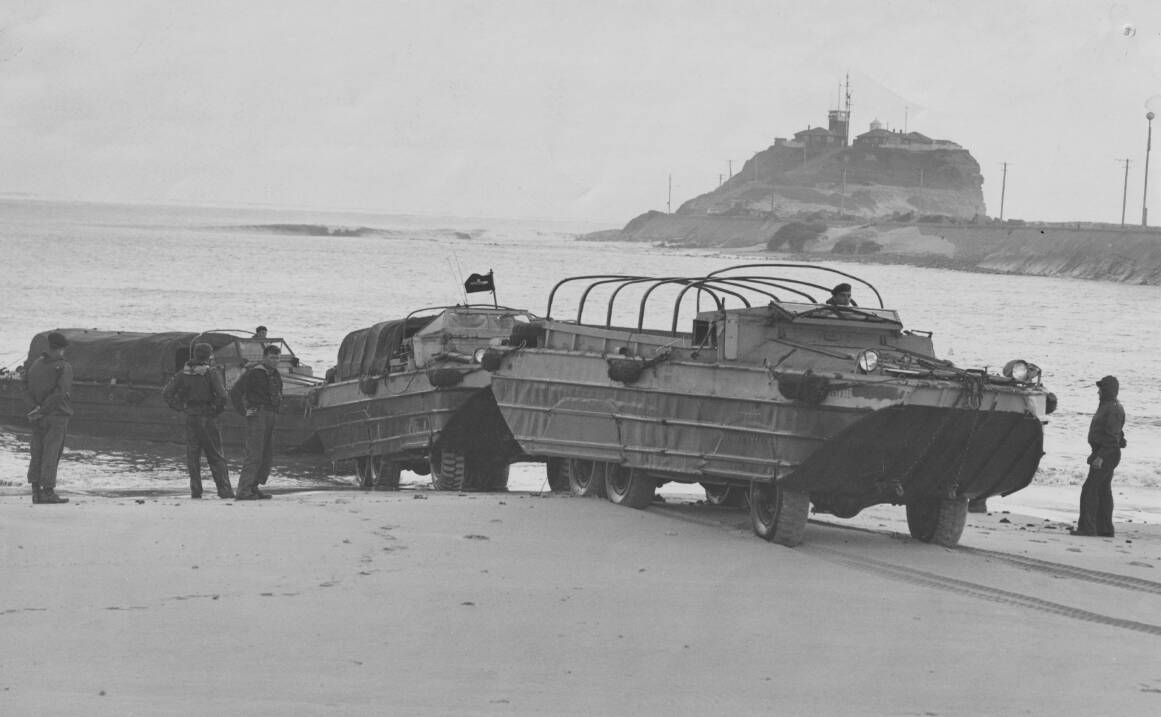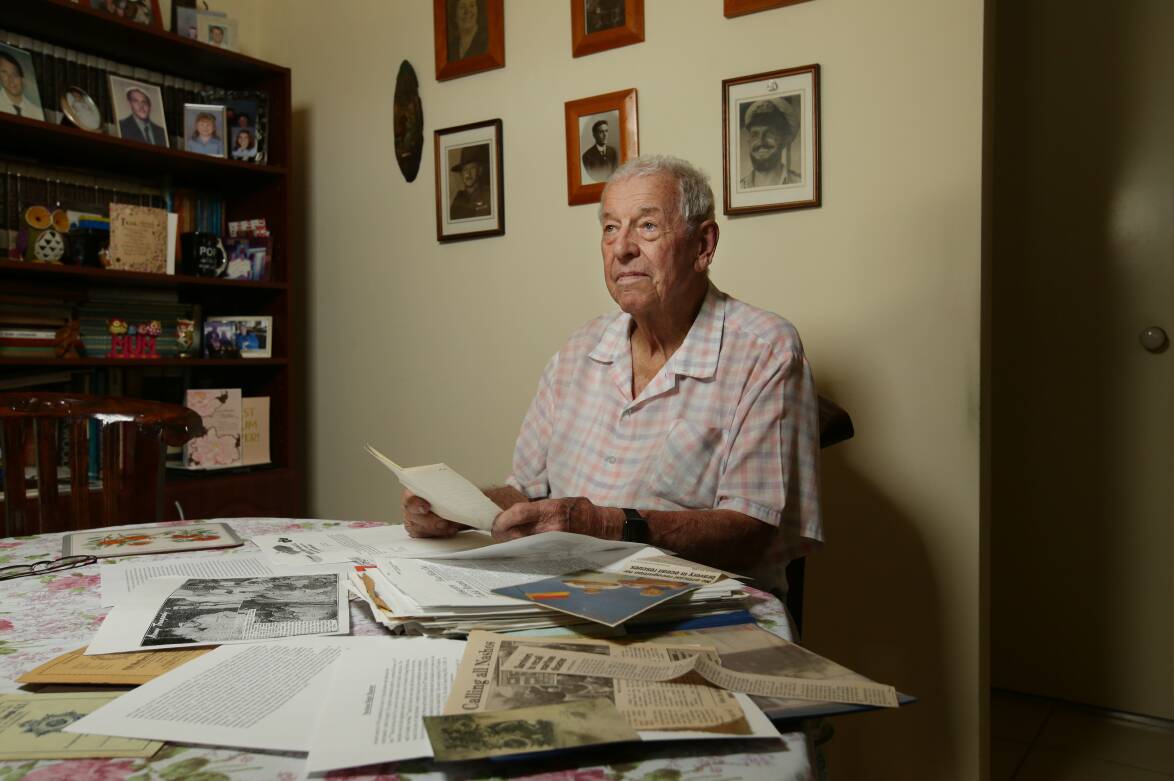
FORTY years ago, a team of scuba divers made an extraordinary discovery in the depths of Stockton Bight.
Sitting upright on sand in deep water three nautical miles off Stockton Beach was a sunken amphibious army tank.
The tank's gun turret had collapsed and there was a light covering of marine growth, otherwise, everything appeared to be intact. The tank's instrument panel, its radio, batteries and seven-cylinder engine were all in place and instantly identifiable.
A Newcastle marine equipment firm had earlier asked the divers to investigate an anomaly which popped up on a depth-sounder. Shifting underwater currents following a storm may have uncovered the bulky tank which would normally have been buried by sand.
Broad details of the 1984 find, including dimensions and its condition, were recorded but the tank's exact position was not disclosed because of the fear that divers might take souvenirs. Authorities were notified under the Historic Shipwrecks Act.
The strange find was not entirely unexpected, as it was one of five lost tanks, or "cans", sunk in mountainous seas in the area during a fatal army exercise in March 1954.
Code-named Operation Seagull, it was one of Australia's worst peacetime military disasters, involving three deaths combined with a total of eight missing vehicles. It was a miracle there weren't many more casualties.
The tragedy became known as the Stockton Bight military disaster and involved 184 CMF (Army Reserve) soldiers and others taking part in a National Service training camp with the 15th Northern River Lancers.

A convoy of 20 amphibious vehicles, including amphibious armoured tanks (LVT's) and army "ducks" (DUKWs - floating lorries, really), stretched over about a kilometre when they left about 2am from Camp Shortland's wave trap (today's Horseshoe Beach) near the Newcastle Harbour entrance.
They were headed towards the ominously named Cemetery (or Birubi) Point in the distant gloom ahead.
The skies were clear and seas smooth when the flotilla left the beach. But at 3am, a southerly squall created rough seas. Waves up to six metres tall hit the low-freeboard vehicles, capsizing some immediately.
In the darkness, eight vehicles were soon either swamped or pulled down with some 100 soldiers tipped into the raging, shark-infested sea. Wearing "Mae Wests" (life preservers) they clung to each other, tried to climb onto nearby vehicles in the choppy sea or tried to strike out for shore about two nautical miles away through dangerous surf.
Later, in the dawn light, the beach was strewn with debris and exhausted soldiers. It was like a scene from Dunkirk.
Next Saturday will mark the 70th anniversary of the disaster. Former CMF soldiers and the few remaining survivors of the tragedy will gather at Fort Scratchley, at 11am for a private commemoration and reunion.
A mere six 1954 exercise survivors are known to exist and have been invited to attend, although age or illness may prevent some from doing so. It may also be the last time such a service is held.
Amid the beach chaos that early March 1954 morning, the acknowledged hero was the late sergeant Don McHattie who was later awarded the George Medal for outstanding courage and leadership. He helped save at least nine men in a wild sea.
"I had nightmares for six months afterwards," he told me after a rare, special memorial service back in 1990.
He wasn't the sole hero. Praise was also heaped on five Stockton lifesavers and a policeman for rescues, including some soldiers who swirled around in the current 200m from the beach for about three hours.
Newcastle solicitor Cliff McDonald (then a 24-year-old captain) once said it was six hours before his own craft reached shore.
"Most of the amphibious tanks broke down and were being towed by the DUKWS, which were then pulled down in the heavy seas with the extra 16-tonne weight behind them," he said.
Almost a year ago, in the absence of any planned 2023 commemoration, one of the few survivors, Elermore Vale's Glanmor Willcox, then 89 years, penned a "short take" to the Newcastle Herald to remind people of the tragedy long ago. He said the military disaster involved a lot of citizen soldiers and occurred on their first camp.
"They must not be forgotten," he wrote.
Later, Willcox told The Herald's Damon Cronshaw he was on a new "duck" which didn't sink during the emergency.
Scores of men thrown overboard were poor swimmers and needed help. Some held hands in a circle to stay together and were picked up after 30 minutes, while the current carried others towards the beach.
Other servicemen thought they were safe, before their craft were swamped by the breakers close to the beach, Willcox said. Three men drowned with the body of one of them, Private R. Blackie, never found. Another 10 soldiers were taken to hospital.
Weekender tracked down another eye-witness, Bill Rummery, now 88 years, from Katoomba. He's also keen to attend the commemoration service next Saturday.
Rummery said he had vivid memories of events of the 1954 disaster.
"We were all out in the water, about 300m from shore in surf which seemed to be 15 feet (4.5m) high. People were calling out for help, but I wasn't much of a swimmer and was flat out saving myself. It was a very rough sea. An awful experience" he said.
And once gratefully safe onshore, Rummery thought about missing mates and how he and others had also stocked up on a fortnight's worth of cigarettes for the camp exercise but this supply was now lost.
"They all went down in the sea," he said.
Soon after though, Rummery said he had another fright.
"We had to go out and bring a (floating) tank back in. We were coming back and our vehicle bumped three times (in the shallows) and then stood on its nose in the sea. I thought I was gone. It was rough surf. My vehicle was standing up on its end and I was up to my neck in water."
Postscript: A 2009 NSW Heritage Branch sonar survey re-located the same sunken LVT (A) 4 tank originally found in 1984 by skindivers. It was facing east on the sea bottom almost 32m under water.







